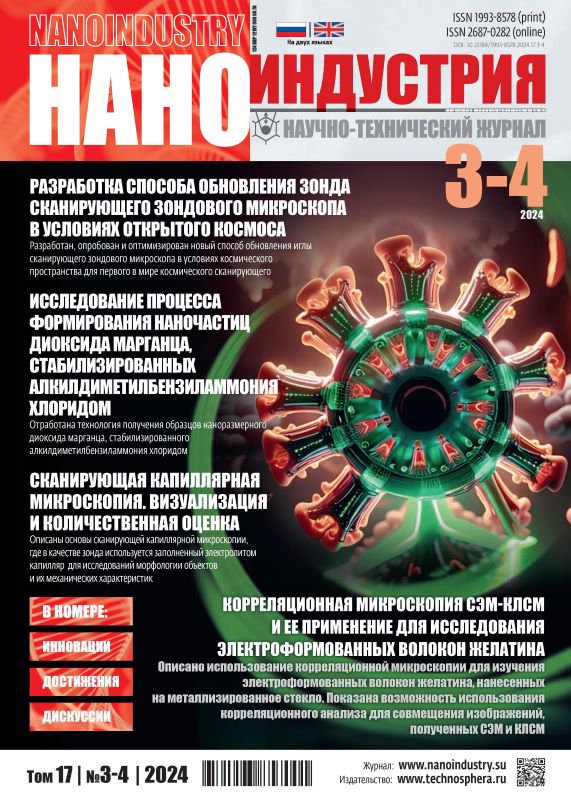Laboratory complex for obtaining colloidal photonic-crystal structures. Part 1
- Authors: Panfilova E.V.1, Diubanov V.A.1, Ibragimov A.R.1, Shramko D.Y.1
-
Affiliations:
- Bauman Moscow State Technical University (National Research university)
- Issue: Vol 17, No 3-4 (2024)
- Pages: 190-199
- Section: Equipment for Nanoindustry
- URL: https://journals.eco-vector.com/1993-8578/article/view/633082
- DOI: https://doi.org/10.22184/1993-8578.2024.17.3-4.190.198
- ID: 633082
Cite item
Abstract
Colloidal photonic crystal structures are a promising material for nanoengineering. The goal of the work was to create a set of scalable equipment for the synthesis of monodisperse colloidal particles and the production of superlattices from them. The authors presented a description of the kit, the results of a study of the structures and formulated recommendations for the design of equipment and the implementation of technological processes.
Full Text
About the authors
E. V. Panfilova
Bauman Moscow State Technical University (National Research university)
Author for correspondence.
Email: panfilova.e.v@bmstu.ru
ORCID iD: 0000-0001-7944-2765
Cand. of Sci. (Tech), Docent
Russian Federation, MoscowV. A. Diubanov
Bauman Moscow State Technical University (National Research university)
Email: panfilova.e.v@bmstu.ru
ORCID iD: 0009-0007-8569-3270
Postgraduate
Russian Federation, MoscowA. R. Ibragimov
Bauman Moscow State Technical University (National Research university)
Email: panfilova.e.v@bmstu.ru
Assistant
Russian Federation, MoscowD. Yu. Shramko
Bauman Moscow State Technical University (National Research university)
Email: panfilova.e.v@bmstu.ru
ORCID iD: 0000-0002-0824-6772
Assistant
Russian Federation, MoscowReferences
- Панфилова Е.В. Перспективные методы формирования планарных наноструктур // Наноинженерия, Машиностроение. 2014. № 8. С. 29–33.
- Chen G., Hong W. Mechanochromism of structural-colored materials // Advanced Optical Materials. 2020. Vol. 8. No. 19. P. 2000984.
- Ding T. et al. Revealing invisible photonic inscriptions: images from strain // ACS Applied Materials & Interfaces. 2015. Vol. 7. No. 24. PP. 13497–13502.
- Inan H. et al. Photonic crystals: emerging biosensors and their promise for point-of-care applications // Chemical Society Reviews. 2017. Vol. 46. No. 2. PP. 366–388.
- Hongbo X. et al. H2O-and ethanol concentration-responsive polymer/gel inverse opal photonic crystal // Journal of Colloid and Interface Science. 2022. Vol. 605. PP. 803–812.
- Kocak G., Tuncer C., Bütün V. pH-Responsive polymers // Polymer Chemistry. 2017. Vol. 8. No. 1. PP. 144–176.
- He G., Manthiram A. Nanostructured Li2MnSiO4/C cathodes with hierarchical macro-/mesoporosity for lithium-ion batteries // Advanced Functional Materials. 2014. Vol. 24. No. 33. PP. 5277–5283.
- Hines L. et al. Soft actuators for small-scale robotics // Advanced materials. 2017. Vol. 29. No. 13. P. 1603483.
- Wang Y. et al. Chameleon-inspired structural-color actuators // Matter. 2019. Vol. 1. No. 3. PP. 626–638.
- Joshi G.K. et al. Ultrasensitive photoreversible molecular sensors of azobenzene-functionalized plasmonic nanoantennas // Nano Letters. 2014. Vol. 14. No. 2. PP. 532–540.
- Ming T. et al. Resonance-Coupling-Based Plasmonic Switches // Small. 2010. Vol. 6. No. 22. PP. 2514–2519.
- Franklin D. et al. Polarization-independent actively tunable colour generation on imprinted plasmonic surfaces // Nature communications. 2015. Vol. 6. No. 1. P. 7337.
- Shao L., Zhuo X., Wang J. Advanced plasmonic materials for dynamic color display // Advanced Materials. 2018. Vol. 30. No. 16. P. 1704338.
- Puzzo D.P. et al. Electroactive inverse opal: a single material for all colors // Angewandte Chemie. 2009. Vol. 121. No. 5. PP. 961–965.
- Walish J.J. et al. Bioinspired electrochemically tunable block copolymer full color pixels // Advanced Materials. 2009. Vol. 21. No. 30. PP. 3078–3081.
- Nonappa. Precision nanoengineering for functional self-assemblies across length scales // Chemical Communications. 2023. Vol. 59. No. 93. PP. 13800–13819.
- Панфилова Е.В., Хань Н.Т.Х., Дюбанов В.А. Разработка процесса получения коллоидного монослоя полистирола для технологии микросферной литографии // Инженерный журнал: наука и инновации. 2020. № 10 (106). P. 8.
- Narayanan S. et al. Thin photonic crystal templates for enhancing the SERS signal: a case study using very low concentrations of dye molecules // Physica Scripta. 2024. Vol. 99. No. 3. P. 035512.
- Snapp P. et al. Colloidal photonic crystal strain sensor integrated with deformable graphene phototransducer // Advanced Functional Materials. 2019. Vol. 29. No. 33. P. 1902216.
- Беседина К.Н. Разработка методов управляемого формирования и исследование тонкопленочных опаловых наноструктур: дис. на соискание ученой степени кандидата технических наук. Москва, 2014.
- Ko Y.G., Shin D.H. Effects of liquid bridge between colloidal spheres and evaporation temperature on fabrication of colloidal multilayers // The Journal of Physical Chemistry B. 2007. Vol. 111. No. 7. PP. 1545–1551.
Supplementary files









